
Frederick William Vanderbilt was a member of the American Vanderbilt family. He was a director of the New York Central Railroad for 61 years, and also a director of the Pittsburgh and Lake Erie Railroad and of the Chicago and North Western Railroad.

Vanderbilt Mansion National Historic Site is a historic house museum in Hyde Park, New York. It became a National Historic Landmark in 1940. It is owned and operated by the National Park Service.

Marble House a Gilded Age mansion located at 596 Bellevue Avenue in Newport, Rhode Island, was built from 1888 to 1892 as a summer cottage for Alva and William Kissam Vanderbilt and was designed by Richard Morris Hunt in the Beaux Arts style. It was unparalleled in opulence for an American house when it was completed in 1892. Its temple-front portico resembles that of the White House.
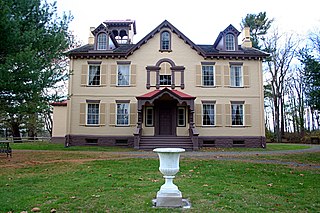
Martin Van Buren National Historic Site is a unit of the United States National Park Service in Columbia County, New York, 1 mile (1.6 km) south of the village of Kinderhook, 125 miles (201 km) north of New York City and 20 miles (32 km) south of Albany. The National Historic Site preserves the Lindenwald estate and thirty-six room mansion of Martin Van Buren, the eighth President of the United States. Van Buren purchased the estate during his presidency in 1839, and it became his home and farm from his leaving office in 1841 until his death in 1862.
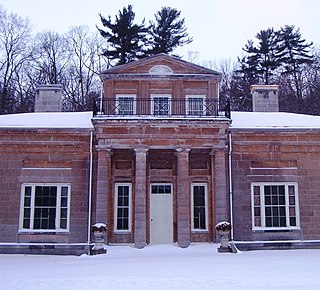
Hyde Hall is a neoclassical country mansion designed by architect Philip Hooker for George Clarke (1768–1835), a wealthy landowner. The house was constructed between 1817 and 1834, and designed with English and American architectural features. It was designated a National Historic Landmark in 1986 for its architecture, and the completeness of its architectural documentary record. It is one of the few surviving works of Philip Hooker, a leading 19th-century American architect.
Philip Hooker was an American architect from Albany, New York known for Hyde Hall, the facade of the Hamilton College Chapel, The Albany Academy, Albany City Hall, and the original New York State Capitol building.
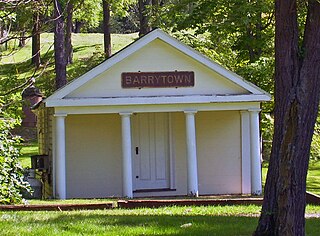
Barrytown is a hamlet within the town of Red Hook in Dutchess County, New York, United States. It is within the Hudson River Historic District, a National Historic Landmark, and contains four of the Hudson River Valley estates: Edgewater, Messena, Rokeby, and Sylvania.
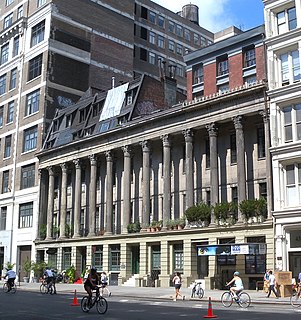
Colonnade Row, also known as LaGrange Terrace, on present-day Lafayette Street in New York City's NoHo neighborhood, is a landmarked series of Greek revival buildings originally built in the early 1830s. They are believed to have been built by Seth Geer, although the project has been attributed to a number of other architects. The buildings' original name comes from the Marquis de Lafayette's estate in France, but the series of nine row houses, of which four remain, owe their existence to John Jacob Astor, who bought the property and whose grandson John Jacob Astor III later lived at No. 424. The buildings are listed on the National Register of Historic Places under the name LaGrange Terrace and the facades remain standing on Lafayette Street south of Astor Place.

The Vanderbilt Lane Historic District is a small area along the street of the same name, just east of US 9 in Hyde Park, New York, United States. It was used for the farm functions of the nearby estate of Walter Langdon and, later, Frederick Vanderbilt. Most of its buildings date to the turn of the 19th century, with one remaining from the 1830s.

Rokeby, also known as La Bergerie, is a historic estate and federally recognized historic district located at Barrytown in Dutchess County, New York. It includes seven contributing buildings and one contributing structure.

The Scarborough Historic District is a national historic district located in the suburban community of Scarborough-on-Hudson, in Briarcliff Manor, New York. The 376-acre (152 ha) district was added to the National Register of Historic Places in 1984, and contains seven historically and architecturally significant properties dating from the late 18th century to the early 20th century. Most of the properties are domestic, or used for education or religion. The most common architectural styles within the district are Mid-19th Century Revival and Late Victorian.

The Eustis Estate is a historic family estate on Canton Avenue in Milton, Massachusetts. Its centerpiece is the mansion house of William Ellery Channing Eustis, an eclectic Late Victorian stone building designed by preeminent architect William Ralph Emerson and constructed in 1878. The estate also includes several other houses associated with the Eustis family, and a gatehouse and stable historically associated with the main estate. The estate was listed on the National Register of Historic Places as a historic district in 2016. Most of the original estate is owned by Historic New England, and was opened to the public as a museum property in 2017.
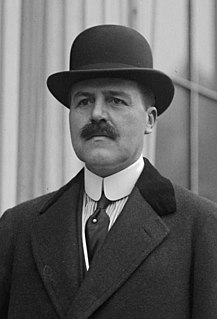
Peter Augustus Jay was an American diplomat who served as U.S. General Consul to Egypt, U.S. Minister to El Salvador and Romania and U.S. Ambassador to Argentina.
DeLancey Astor Kane was an American soldier and horseman who was prominent in New York Society during the Gilded Age. He was called the "father of coaching in the United States."
Samuel Nicholson Kane was an American soldier and sailor prominent in New York Society during the Gilded Age who served as the Commodore of New York Yacht Club.
Sybil Kent Kane was an American socialite who was prominent in New York Society during the Gilded Age.
Franklin Hughes Delano was an American merchant, diplomat and society man.
John Innes Kane was an American explorer, scientist and philanthropist who was prominent in New York Society during the Gilded Age.

Augustus Jay was an American diplomat and member of the prominent Jay family.






















